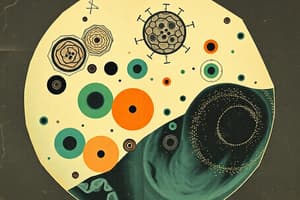Podcast
Questions and Answers
What is the control center of the cell?
What is the control center of the cell?
nucleus
What surrounds the nucleus?
What surrounds the nucleus?
- Endoplasmic reticulum
- Cell membrane
- Ribosomes
- Nuclear envelope (correct)
Humans have 46 chromosomes in every cell.
Humans have 46 chromosomes in every cell.
False (B)
What are ribosomes made out of?
What are ribosomes made out of?
What type of ribosomes are found in the cytoplasm?
What type of ribosomes are found in the cytoplasm?
What is the function of the rough endoplasmic reticulum (RER)?
What is the function of the rough endoplasmic reticulum (RER)?
What is produced in the smooth endoplasmic reticulum (SER)?
What is produced in the smooth endoplasmic reticulum (SER)?
What is the control center of the cell?
What is the control center of the cell?
The nuclear envelope is a single membrane structure.
The nuclear envelope is a single membrane structure.
What type of RNA do ribosomes use to translate information?
What type of RNA do ribosomes use to translate information?
Humans have __ chromosomes in every cell.
Humans have __ chromosomes in every cell.
What are the two types of Endoplasmic Reticulum?
What are the two types of Endoplasmic Reticulum?
What is the function of the Rough Endoplasmic Reticulum (RER)?
What is the function of the Rough Endoplasmic Reticulum (RER)?
Match the following ribosome types with their functions:
Match the following ribosome types with their functions:
Flashcards are hidden until you start studying
Study Notes
Nucleus
- Serves as the cell's control center, housing genetic material.
- Contains DNA organized into structures called chromosomes; humans have 23 chromosomes per cell.
- Enclosed by a double membrane known as the nuclear envelope, which separates nuclear contents from cytoplasm.
- Features nuclear pores that allow selective transport of substances in and out of the nucleus.
- Pore complexes consist of proteins that regulate the passage of molecules through the nuclear pores.
Ribosomes
- Composed of ribosomal RNA (rRNA) and proteins, they are essential for protein synthesis.
- Translate messenger RNA (mRNA) sequences to assemble amino acids into proteins.
- Free ribosomes float in the cytoplasm, synthesizing proteins for internal cellular use.
- Bound ribosomes are attached to the endoplasmic reticulum (ER), producing proteins for membrane incorporation or export outside the cell.
Endoplasmic Reticulum (ER)
- Divided into two types: Rough Endoplasmic Reticulum (RER) and Smooth Endoplasmic Reticulum (SER).
Rough Endoplasmic Reticulum (RER)
- Characterized by ribosomes bound to its surface, giving it a "rough" appearance.
- Continuous with the nuclear membrane, facilitating direct communication.
- Ribosomes synthesize proteins that are threaded into the RER, where they fold into functional shapes and are packaged into vesicles for transport.
Smooth Endoplasmic Reticulum (SER)
- Lacks ribosomes; involved primarily in lipid synthesis.
- Responsible for the production of steroids, phospholipids, and oils, contributing to the formation of cellular membranes.
Nucleus
- Acts as the cell’s control center, housing DNA.
- Encased in a double membrane known as the nuclear envelope.
- The envelope features tiny pores for selective substance exchange between the nucleus and cytoplasm.
- Nuclear pore complexes regulate the movement of materials, ensuring proper communication and control.
- Chromatin organizes into chromosomes, with humans possessing 23 pairs in each cell.
- Chromosomes remain loosely coiled for access to genetic information.
Ribosomes
- Composed of proteins and rRNA (ribosomal RNA).
- Responsible for translating messenger RNA (mRNA) instructions to synthesize proteins.
- Free ribosomes operate in the cytoplasm, producing proteins for internal cellular use.
- Bound ribosomes, attached to the endoplasmic reticulum (ER), synthesize proteins for incorporation into membranes or export outside the cell.
Endoplasmic Reticulum
- Divided into two types: Rough Endoplasmic Reticulum (RER) and Smooth Endoplasmic Reticulum (SER).
RER
- Characterized by attached ribosomes, appearing “rough” under a microscope.
- Continuous with the nuclear membrane, facilitating protein production and processing.
- Newly synthesized proteins enter the RER through pores, where they fold into functional shapes.
- Proteins exit the RER encased in vesicles for further transportation.
SER
- Lacks ribosomes, giving it a smooth appearance.
- Primarily involved in lipid synthesis, producing steroids, phospholipids, and oils essential for various cellular functions.
Studying That Suits You
Use AI to generate personalized quizzes and flashcards to suit your learning preferences.




